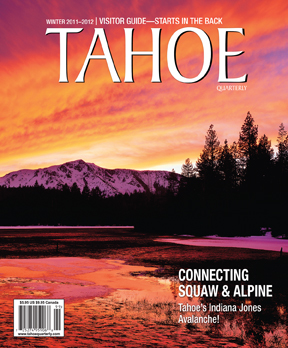The Dark Side of the Snow

A mountaintop shrine marks the boundaries of Goryu ski area in Hakuba, Japan. Outside of the ropes, avalanche danger loomed during a March 2011 snowboard trip.
By Seth Lightcap
Backcountry skiing and riding are increasingly popular around Tahoe, but to avoid an experience like this one, avalanche training and awareness are a necessity.
I got served a stiff lesson about avalanche danger last winter. The punishment took place while snowboarding in the backcountry of Hakuba, Japan. On our first lap of the day I made a poor choice on where to stop, and another rider dropping in from above set off an avalanche on top of me. The shallow but powerful slide washed me down a gully and into a world of hurt.
The vision of lightning bolt-like fracture lines surrounding me on all sides is still tattooed on my brain, clear as day. When it happened I couldn’t even begin to process moving my feet before I was swept onto my ass (language?) by the rush of shattered snow. I remember putting my arms out and trying to stand up, but I was no match for the power of the avalanche. After a hundred feet of flailing the slide sucked me under the surface.
I hadn’t really thought about dying before. Other than a fleeting, “that would suck,” death was not on my radar. But submerged in a torrent of snow, windpipe packed with powder, tumbling between crushing blows, I figured, “This is it. I’m gonna die.”
The seconds simultaneously moved in slow motion and warp speed. Like in a river rapid, there were moments when I’d get caught up in the aerated surface snow and feel like I was absolutely flying down the mountain, no pressure on my body whatsoever. Then I’d hit a hole in the angry, frozen river, each one smashing me, stopping time and sending a shockwave of pain as the compressing snow crushed me on all sides. During one hit, my right binding blew off my snowboard—an unfortunate development as the board attached to only one foot promptly levered my pelvis open like a bottle opener.
All I remember thinking in the darkness of the snowpack was one question: “I’m gonna die in Japan?” Sliding into the blackness, I expected nothing less than a complete burial when I stopped. Thankfully, I was wrong. When the slide spat me out I was sitting on the debris pile not buried an inch!
I was overjoyed not to be buried; but I was also choking. Snow packed my mouth and throat. I ripped off my gloves and started digging my fingers between my teeth, pulling out wads of snow. After a dozen violent coughs I dislodged the last chunk in my throat and took a real breath. I was alive but shaking uncontrollably.
All told I slid nearly 800 feet under the surface of the snow in the coffin position—flat on my back. Though the avalanche was not deep enough to close the casket, it was powerful enough to dislocate my shoulder, tear ligaments in my knee and rip apart my pelvis (meanwhile rupturing an artery in my lower abdomen). Had it not been for a timely helicopter rescue I would have bled out internally and died on that slope.
My mistake that day was a common one for avalanche accidents — I was rushing and didn’t take enough time to assess the snowpack. It was a hard-knock lesson I wish I’d learned in an avalanche awareness class rather than in the mountains. If you’re an avid or aspiring backcountry skier, you owe it to yourself to get educated on avalanche danger before you step out of bounds. Don’t learn the hard way. The dark side of the snow is hell compared to its heavenly, white side.






